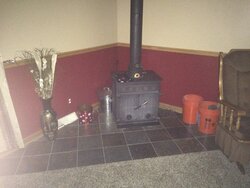I've been wanted to go to wood heat for quite a few years but where I was living the house had a buck stove insert into a chimney and no liner. It was a little more investment than I could afford to get the liner run at the time. We moved recently and the house does have an older free standing stove hooked to a newer chimney (installed about 4 years ago I would say). Had a qualified sweep come out and clean everything out and he said that it was all clean and looked good. Only oddity is the stove is an old 8" flue piped down to a 6" chimney. Not ideal or what he really likes to see but it looked as if everything had been burning just fine with the setup.
I did a test fire earlier this week and it worked fine; really put off some heat. I had identified the stove at one point but it was on my laptop that died. Didn't get that particular file moved over I don't believe.
Now here is my dilemma; I know that I'm not going to have enough good seasoned wood for this season and probably into next. I will be buying some (or possible get an eco-brick solution that I know exactly what I'm getting) until I can get a decent supply of wood that I know is good.
Knowing that I've got to buy wood the amount of wood that I'm burning will be of some concern to me. I'm considering it would be worth my investment getting an Englander 13NCH or 30NCH. How much less wood could I realistically expect to burn with a newer stove? Could I see a 25% reduction or is that over ambitious?
There would be some other benefits to me I think of having a matching flu and chimney size. And since this is something new to me and I have not grown up burning wood I'm thinking it would be beneficial to me having glass and being able to monitor the flame a little better? Or does that not really matter as long as I'm maintaining correct stove temperatures? I'm also going to pull the blower on the current stove and have it worked on; it runs but something is completely right.
I've included a picture of the current stove and setup. I don't think I would have to do anything else with insulation or hearth around it correct? The house is on a slab and the stove on tiles. 27" from the center of the chimney pipe to the walls. 22" from the front of the current stove to the carpet line. Those all seem to fall within the guidelines in the owners manual for the 30-NC if I'm reading it correctly.
It's a 1 story ranch house; 1800 sq feet. The stove is positioned at the midpoint of the house along the front wall.
I did a test fire earlier this week and it worked fine; really put off some heat. I had identified the stove at one point but it was on my laptop that died. Didn't get that particular file moved over I don't believe.
Now here is my dilemma; I know that I'm not going to have enough good seasoned wood for this season and probably into next. I will be buying some (or possible get an eco-brick solution that I know exactly what I'm getting) until I can get a decent supply of wood that I know is good.
Knowing that I've got to buy wood the amount of wood that I'm burning will be of some concern to me. I'm considering it would be worth my investment getting an Englander 13NCH or 30NCH. How much less wood could I realistically expect to burn with a newer stove? Could I see a 25% reduction or is that over ambitious?
There would be some other benefits to me I think of having a matching flu and chimney size. And since this is something new to me and I have not grown up burning wood I'm thinking it would be beneficial to me having glass and being able to monitor the flame a little better? Or does that not really matter as long as I'm maintaining correct stove temperatures? I'm also going to pull the blower on the current stove and have it worked on; it runs but something is completely right.
I've included a picture of the current stove and setup. I don't think I would have to do anything else with insulation or hearth around it correct? The house is on a slab and the stove on tiles. 27" from the center of the chimney pipe to the walls. 22" from the front of the current stove to the carpet line. Those all seem to fall within the guidelines in the owners manual for the 30-NC if I'm reading it correctly.
It's a 1 story ranch house; 1800 sq feet. The stove is positioned at the midpoint of the house along the front wall.


